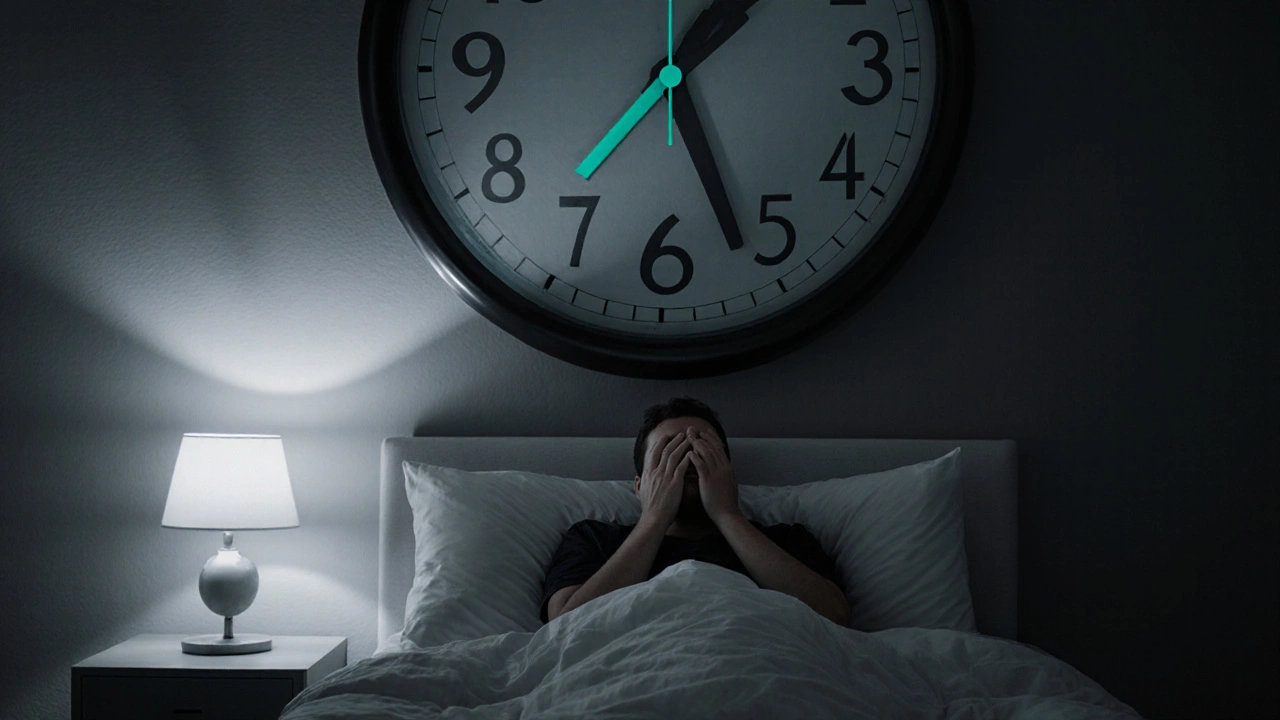Insomnia Treatment Pathway Advisor
Treatment Decision Tool
This tool helps you understand which evidence-based insomnia treatment might be most appropriate based on your symptoms. Always consult a healthcare professional for personalized advice.
Recommended Treatment Pathway
Key Evidence: Research shows CBT-I provides lasting benefits for 70-80% of patients compared to short-term medication use.
If you’ve spent countless nights staring at the ceiling, counting every tick of the clock, you know how draining insomnia can be. While countless blogs promise quick fixes, the reality is that lasting relief often requires guidance from trained professionals. This article breaks down why seeking expert help matters, who to turn to, and which evidence‑based treatments actually work.
Understanding Insomnia
Insomnia is a sleep disorder characterized by difficulty falling asleep, staying asleep, or waking up too early, despite having the opportunity to rest. It affects roughly 10‑30% of adults worldwide and can lead to fatigue, mood swings, reduced cognitive performance, and a higher risk of chronic conditions such as hypertension and diabetes.
Why DIY Approaches Often Fall Short
Most people start with self‑help tactics: cutting caffeine, setting a bedtime routine, or trying over‑the‑counter sleep aids. These steps are valuable but rarely address underlying factors like stress, anxiety, or circadian rhythm disruptions. Without a clear diagnosis, you may keep chasing temporary fixes, which can worsen sleep pressure and even create dependence on medications.
What Professional Help Brings to the Table
Trained clinicians can pinpoint the root cause of your sleeplessness and tailor a plan that blends behavioral strategies with, when needed, medication. Their expertise reduces trial‑and‑error, speeds up improvement, and safeguards you from potential side effects.
Who to Consult for Insomnia
- Sleep specialist is a physician-often a neurologist, pulmonologist, or psychiatrist-who focuses on diagnosing and treating sleep disorders. They can order sleep studies and prescribe therapies based on a comprehensive assessment.
- Primary care physician (PCP) often serves as the first point of contact. They can evaluate medication interactions, rule out medical conditions, and refer you to a sleep specialist if needed.
- Mental health counselor (or therapist) can address anxiety, depression, or trauma that frequently accompany chronic insomnia. They often deliver cognitive‑behavioral therapy for insomnia (CBT‑I).
- Pharmacist can counsel you on the proper use of prescription sleep aids, potential drug interactions, and safe tapering strategies.

Evidence‑Based Treatments Offered by Professionals
The two pillars most sleep experts recommend are Cognitive Behavioral Therapy for Insomnia (CBT‑I), a structured program that changes thoughts and habits around sleep, and prescription sleep medication, which may be necessary for short‑term relief. Below is a quick comparison.
| Aspect | CBT‑I | Sleep Medication |
|---|---|---|
| Core Mechanism | Behavioral change & cognitive restructuring | Pharmacologic alteration of neurotransmitters |
| Typical Duration | 6‑8 weekly sessions | 2‑4 weeks for acute use; longer only under close supervision |
| Long‑term Efficacy | 70‑80% maintain improvements after 1 year | High relapse once medication stops |
| Side‑Effect Profile | Minimal; occasional daytime alertness issues | Drowsiness, dependence, tolerance, rare falls |
| Cost (U.S.) | $150‑$300 per session (often covered by insurance) | $30‑$150 per month depending on drug |
Other Professional Tools You Might Encounter
- Polysomnography is an overnight sleep study performed in a lab, measuring brain waves, oxygen levels, heart rate, and breathing. It helps rule out sleep apnea or periodic limb movement disorder.
- Actigraphy is a wrist‑worn device that records movement patterns for several weeks, giving a real‑world picture of sleep‑wake cycles.
- Sleep hygiene counseling covers practical habits-like limiting screen time, keeping the bedroom cool, and using the bed only for sleep-often integrated into CBT‑I.
How to Start: A Step‑by‑Step Guide
- Schedule a visit with your primary care physician. Bring a sleep diary (track bedtime, wake time, caffeine, alcohol, and feeling of restfulness).
- If the PCP suspects a sleep disorder, ask for a referral to a certified sleep specialist.
- During the specialist appointment, discuss whether CBT‑I, medication, or a combination fits your situation. Request a written treatment plan.
- If CBT‑I is recommended, commit to weekly sessions and practice the assigned exercises (stimulus control, sleep restriction, cognitive restructuring).
- Should medication be needed, have the pharmacist review dosage, timing, and potential interactions with any other prescriptions you take.
- Follow up after 4-6 weeks to assess progress. Adjust the plan based on outcomes-most patients see improvement within the first two weeks of CBT‑I.

What to Expect During Treatment
Professional treatment isn’t a magic bullet; it requires active participation. In CBT‑I, you’ll likely experience initial sleep restriction (shortening time in bed) that feels counterintuitive but gradually consolidates sleep. Medication may bring faster sleep onset, but clinicians will aim to taper off as behavioral changes take hold.
Most patients report a noticeable boost in daytime alertness and mood after 3-4 weeks of consistent therapy. If progress stalls, your provider may suggest additional assessments like polysomnography to explore hidden conditions.
Tips to Maximize Your Success
- Stay consistent: Stick to the same wake‑up time every day, even on weekends.
- Limit bedtime screens: Blue light suppresses melatonin; consider a night‑mode app or amber glasses.
- Watch your diet: Avoid caffeine after 2p.m. and heavy meals within three hours of bedtime.
- Exercise wisely: Regular activity improves sleep, but finish vigorous workouts at least 2hours before sleep.
- Use the bedroom only for sleep (and intimacy): This reinforces the bed‑sleep association.
When Professional Help May Not Be Needed
If you’ve only experienced occasional sleeplessness linked to a stressful event, simple lifestyle tweaks may be sufficient. However, if insomnia persists beyond a month, recurs regularly, or interferes with work and relationships, it’s time to enlist a professional.
Frequently Asked Questions
Can CBT‑I replace sleep medication?
For many patients, CBT‑I becomes the primary long‑term solution. Medication can be used short‑term to ease the transition, but the goal is usually to taper it off once behavioral changes take hold.
How long does a typical CBT‑I program last?
Standard CBT‑I consists of 6‑8 weekly sessions, each lasting about 45‑60 minutes. Some clinics offer group formats or digital platforms that follow the same timeline.
Are there risks associated with prescription sleep aids?
Yes. Common side effects include daytime drowsiness, memory issues, and a risk of dependence, especially with benzodiazepines or Z‑drugs. That’s why clinicians prescribe the lowest effective dose for the shortest duration and monitor progress closely.
What is the role of a sleep study in insomnia treatment?
A sleep study (polysomnography) isn’t always needed for primary insomnia, but it helps rule out other sleep disorders-like sleep apnea-that can mimic or worsen insomnia. Your sleep specialist decides based on symptoms and risk factors.
Can over‑the‑counter melatonin help?
Melatonin can be useful for circadian rhythm shifts (e.g., jet lag or shift work) but offers limited benefit for chronic insomnia unless the sleep issue is linked to a timing problem. Always discuss use with a healthcare provider.
Bottom line: insomnia isn’t just a nightly nuisance-it’s a health issue that deserves professional attention. By partnering with sleep‑trained clinicians, you gain a clear diagnosis, evidence‑backed therapies, and a roadmap to restful nights. Take the first step today and let experts guide you toward the sleep you deserve.







Richard Sucgang
October 15, 2025 AT 12:43Buzzwords don’t replace actual data on insomnia
Russell Martin
October 23, 2025 AT 07:00Yo, real tip: keep a sleep diary for at least two weeks and show it to your doc. It helps pinpoint patterns fast.
Jenn Zee
October 31, 2025 AT 00:18When one peruses the extant literature on nocturnal disturbances, it becomes unequivocally apparent that the layman’s proclivity for oversimplified remedies is nothing short of intellectual negligence.
Insomnia, as a multifactorial syndrome, demands a diagnostic rigor that surpasses anecdotal trial‑and‑error.
The neurobiological underpinnings involve dysregulated hypothalamic pathways, hyperarousal of the autonomic nervous system, and maladaptive conditioned arousal, none of which can be remedied by mere caffeine abstinence.
Moreover, the circadian misalignment often observed in shift workers is a testament to the necessity of chronobiological assessment, which is routinely omitted in popular blogs.
Professional clinicians, equipped with polysomnographic instrumentation, are uniquely positioned to differentiate primary insomnia from comorbid sleep‑related breathing disorders.
Such differentiation is critical because the therapeutic trajectory diverges dramatically; a patient with undiagnosed obstructive sleep apnea will not benefit from CBT‑I alone.
Cognitive Behavioral Therapy for Insomnia, when administered by certified therapists, systematically attenuates maladaptive sleep cognitions through stimulus control and sleep restriction, yielding durable remission rates exceeding seventy percent.
In contrast, pharmacologic agents, while efficacious for acute induction, engender tolerance, rebound insomnia, and potential dependence, especially within the benzodiazepine and non‑benzodiazepine classes.
The financial calculus also favors behavioral interventions; insurance reimbursement policies increasingly recognize CBT‑I as a cost‑effective modality compared with indefinite medication use.
Patients who persist with self‑help regimens often experience an ironic exacerbation of nocturnal vigilance, reinforcing the very insomnia they seek to alleviate.
Thus, the argument for professional engagement is not merely an appeal to authority but a substantiated claim grounded in empirical outcomes.
It is incumbent upon individuals suffering from chronic sleep disruption to seek out clinicians who can furnish a comprehensive, evidence‑based plan.
Only through such a collaborative, interdisciplinary approach can the pernicious cycle of insomnia be broken.
In sum, the pursuit of expertise supersedes the allure of quick fixes, delivering both immediate relief and long‑term sleep health.
don hammond
November 7, 2025 AT 18:36Oh sure, just pop a pill and hope for the best 🙄💤. Meanwhile, the rest of us are actually trying things that work.
Ben Rudolph
November 15, 2025 AT 12:55Another self‑help fluff piece.
Ian Banson
November 23, 2025 AT 07:13In Britain we’ve long recognized that insomnia isn’t solved by American quick‑fix culture; we rely on structured CBT‑I programmes and rigorous medical oversight.
marcel lux
December 1, 2025 AT 01:31I totally agree with the CBT‑I emphasis; it’s a solid evidence‑based route that many overlook in favor of hype.
Charlotte Shurley
December 8, 2025 AT 19:50A consistent wake‑time, even on weekends, anchors the circadian rhythm.